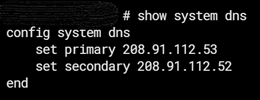- Support Forum
- Knowledge Base
- Customer Service
- Internal Article Nominations
- FortiGate
- FortiClient
- FortiADC
- FortiAIOps
- FortiAnalyzer
- FortiAP
- FortiAuthenticator
- FortiBridge
- FortiCache
- FortiCare Services
- FortiCarrier
- FortiCASB
- FortiConverter
- FortiCNP
- FortiDAST
- FortiData
- FortiDDoS
- FortiDB
- FortiDNS
- FortiDLP
- FortiDeceptor
- FortiDevice
- FortiDevSec
- FortiDirector
- FortiEdgeCloud
- FortiEDR
- FortiEndpoint
- FortiExtender
- FortiGate Cloud
- FortiGuard
- FortiGuest
- FortiHypervisor
- FortiInsight
- FortiIsolator
- FortiMail
- FortiManager
- FortiMonitor
- FortiNAC
- FortiNAC-F
- FortiNDR (on-premise)
- FortiNDRCloud
- FortiPAM
- FortiPhish
- FortiPortal
- FortiPresence
- FortiProxy
- FortiRecon
- FortiRecorder
- FortiSRA
- FortiSandbox
- FortiSASE
- FortiSASE Sovereign
- FortiScan
- FortiSIEM
- FortiSOAR
- FortiSwitch
- FortiTester
- FortiToken
- FortiVoice
- FortiWAN
- FortiWeb
- FortiAppSec Cloud
- Lacework
- Wireless Controller
- RMA Information and Announcements
- FortiCloud Products
- ZTNA
- 4D Documents
- Customer Service
- Community Groups
- Blogs
- Fortinet Community
- Knowledge Base
- FortiGate
- Technical Tip: FQDN based firewall policies are no...
- Subscribe to RSS Feed
- Mark as New
- Mark as Read
- Bookmark
- Subscribe
- Printer Friendly Page
- Report Inappropriate Content
Description
This article describes FQDN address objects that are used in firewall policies that are not working intermittently.
Scope
FortiGate.
Solution
When an FQDN-based destination address object in firewall policies is used, whenever incoming traffic comes from LAN to WAN, it should hit the configured firewall policy with the FQDN destination object, if all the other required fields match the firewall policy.
If the traffic is not hitting the expected FQDN-based firewall policy, follow the steps below:
- Check if the FortiGate can resolve the domain:

list-all List FQDN.
diagnose test application dnsproxy 6
-
If FortiGate can resolve to an IP address, make sure the DNS settings on FortiGate and the client machine are the same.

-
If the DNS settings configured on FortiGate and the client machine are different, configure the FortiGate or client machine to use the same DNS server and flush the client DNS cache using "ipconfig /flushdns" and check if that resolves the issue.
-
If the issue persists after configuring the same DNS server settings on both FortiGate and client machines and if the destination FQDN resolves to a different IP very frequently, try with a wildcard FQDN object instead of the full FQDN.
-
Sometimes, the default TTL (time-to-live) value of the FQDN is very small, so we might observe that IP resolution on the endpoint and FortiGate are different at times, even when using the same DNS Servers. It is good to increase the cache-ttl value for that FQDN on the FortiGate.
config firewall address
edit "example.com”
set type fqdn
set fqdn "example.com"
set cache-ttl 86400 <- {0 - 86400 in seconds}, where 0 means default.
next
end
If the firewall fqdn address cache-ttl is set to 0 (default), the cache information will be ignored, and the global dns-cache-ttl (default = 1800s) will be used.
About Wildcard FQDNs:
- Support for wildcard FQDN addresses in firewall policy has been included in v6.2.2.
- When the wildcard FQDN has been configured, it will show as an unresolved FQDN in the firewall address list.
- As compared to the standard FQDNs, the wildcard FQDN does not use system DNS settings under Network -> DNS.
- The wildcard FQDN is updated when a DNS query is made from a host connected to FortiGate (DNS traffic passing through a FortiGate).
- If the query matches the wildcard FQDN, the IP address is added to the cache for that object on the FortiGate. Make sure that the DNS traffic is passing through the FortiGate.
- DNS traffic using DNS-over-HTTPS protocol is not supported.
- From v7.0, FortiGate supports DNS-over-TLS provided that there is a firewall policy that allows DNS traffic and is configured with DNS Filter and Deep Packet Inspection.
-
Note that the DNS-UDP session helper is configured by default. If an administrator removes the DNS-UDP session helper, wildcard FQDNs will not be resolved when devices behind FortiGate attempt DNS queries.
config system session-helper
...
edit 14
set name dns-udp
set protocol 17
set port 53
next
end
Support for wildcard FQDN addresses in firewall policy 6.2.2
Technical Tip: Using wildcard FQDN
Technical Tip: FQDN Wildcard address is not resolved when using it in Firewall Policies
The Fortinet Security Fabric brings together the concepts of convergence and consolidation to provide comprehensive cybersecurity protection for all users, devices, and applications and across all network edges.
Copyright 2025 Fortinet, Inc. All Rights Reserved.